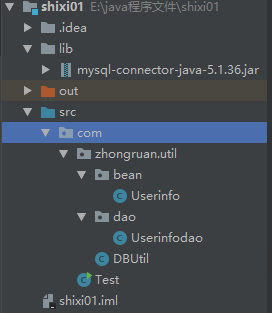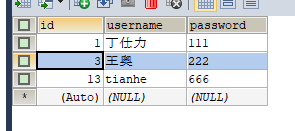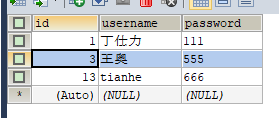The items involved in this experiment are as follows:

It mainly involves four java files:
Test.java
Userinfo.java
Userinfodao.java
DBUtil.java
Let's explain one by one:
The Userinfo code is as follows: this part is mainly entity class, corresponding to database.
package com.zhongruan.util.bean;
public class Userinfo {
private int id;
private String username;
private String password;
public int getId() {
return id;
}
public String getUsername() {
return username;
}
public String getPassword() {
return password;
}
public void setId(int id) {
this.id = id;
}
public void setUsername(String username) {
this.username = username;
}
public void setPassword(String password) {
this.password = password;
}
@Override
public String toString() {
return "Userinfo{" +
"id=" + id +
", username='" + username + '\'' +
", password='" + password + '\'' +
'}';
}
}
The code of Userinfodao.java is as follows: this part is the persistence layer, which stores the functions of adding, deleting, querying and modifying database.
package com.zhongruan.util.dao;
import com.zhongruan.util.DBUtil;
import com.zhongruan.util.bean.Userinfo;
import java.sql.Connection;
import java.sql.PreparedStatement;
import java.sql.ResultSet;
import java.util.ArrayList;
import java.util.List;
public class Userinfodao {
public List<Userinfo> findAll(){
Connection connection = null;
PreparedStatement statement = null;
ResultSet rs = null;
List<Userinfo> list=new ArrayList<>();
try {
connection= DBUtil.getconnection();
//3. write sql
String sql = "select* from userinfo";
//4. Get the statement object
statement = connection.prepareStatement(sql);
//5. Execute sql to get result set
rs = statement.executeQuery();
//6. Processing result set
while (rs.next()) {
Userinfo userinfo=new Userinfo();
userinfo.setId(rs.getInt(1));
userinfo.setUsername(rs.getString(2));
userinfo.setPassword(rs.getString(3));
list.add(userinfo);
}
/* 7.close resource */
} catch (Exception e) {
e.printStackTrace();
} finally {
DBUtil.close(connection,statement,rs);
}
return list;
}
public void add(){
Connection connection = null;
PreparedStatement statement = null;
try {
connection= DBUtil.getconnection();
//3. write sql
String sql = "insert into userinfo (username,password) values(?,?)";
//4. Get the statement object
statement = connection.prepareStatement(sql);
statement.setString(1,"tianhe");
statement.setString(2,"666");
statement.executeUpdate();
/* 7.close resource */
} catch (Exception e) {
e.printStackTrace();
} finally {
DBUtil.close(connection,statement,null);
}
}
public void delete(){
Connection connection = null;
PreparedStatement statement = null;
try {
connection= DBUtil.getconnection();
//3. write sql
String sql = "delete from userinfo where username='Wang Ao'";
//4. Get the statement object
statement = connection.prepareStatement(sql);
statement.executeUpdate();
/* 7.close resource */
} catch (Exception e) {
e.printStackTrace();
} finally {
DBUtil.close(connection,statement,null);
}
}
public void update(){
Connection connection = null;
PreparedStatement statement = null;
try {
connection= DBUtil.getconnection();
//3. write sql
String sql = "update userinfo set password=555 where id=3";
//4. Get the statement object
statement = connection.prepareStatement(sql);
statement.executeUpdate();
/* 7.close resource */
} catch (Exception e) {
e.printStackTrace();
} finally {
DBUtil.close(connection,statement,null);
}
}
}
DBUtil.java is the tool part, which is mainly used to connect and close the database. Code:
package com.zhongruan.util;
import java.sql.*;
public class DBUtil {
public static Connection getconnection(){
Connection connection = null;
//1. Loading drive
try {
Class.forName("com.mysql.jdbc.Driver");
//2. Create a connection
connection = DriverManager.getConnection
("jdbc:mysql://127.0.0.1:3306/user?useSSL=true&" +
"characterEncoding=utf-8&user=" +
"root&password=123");
System.out.println("Connection created successfully");
} catch (Exception e) {
e.printStackTrace();
}
return connection;
}
public static void close(Connection connection,PreparedStatement statement,ResultSet rs) {
if (rs != null) {
try {
rs.close();
} catch (SQLException e) {
e.printStackTrace();
}
}
if (statement != null) {
try {
statement.close();
} catch (SQLException e) {
e.printStackTrace();
}
}
if (connection != null) {
try {
connection.close();
} catch (SQLException e) {
e.printStackTrace();
}
}
}
}
Test.java is the class of the main function of the whole operation. It calls methods in the other three classes to add, delete, query and modify:
ackage com;
import com.zhongruan.util.dao.Userinfodao;
public class Test {
public static void main(String[] args) {
Userinfodao userinfodao=new Userinfodao();
//List<Userinfo> list=userinfodao.findAll();
//userinfodao.add();
//userinfodao.delete();
userinfodao.update();
}
}
Take the modification as an example to show the running results:
Table information of the original database:
Now change the password of the user with id=3 to 555
Function:
View the database table information. Modification succeeded: